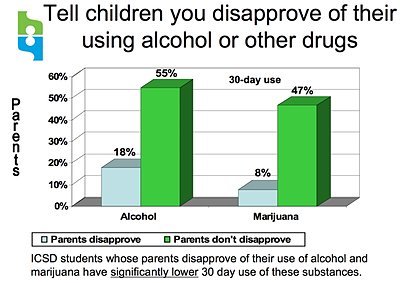- By Dan Veaner
- Around Town
 Print
Print  8% of Tompkins County students whose parents disapprove of their drinking actually drink. 55% of students whose parents approve or don't care if they drink use alcohol. 8% of kids whose parents disapprove of marijuana use use it. 47% of kids whose parents approve or don't care use it. What's scarier? That kids abuse substances? Or that parents don't mind if their kids use them?
8% of Tompkins County students whose parents disapprove of their drinking actually drink. 55% of students whose parents approve or don't care if they drink use alcohol. 8% of kids whose parents disapprove of marijuana use use it. 47% of kids whose parents approve or don't care use it. What's scarier? That kids abuse substances? Or that parents don't mind if their kids use them?And how about this: Tompkins County kids who participate in extra curricular activities 10 or more times are actually more likely than kids who don't participate in any extra curriculars to drink, smoke marijuana, and binge, as well as liking school and doing their best work -- a very mixed bag.
That information comes from the Youth Development Survey that was answered anonymously Tompkins County 6th through 12th graders in 2010. This spring the results were shared with participating school districts, and they are not always what you would expect. Kris Bennett, of the Tompkins County Youth Services Department, presented some of the survey results for Ithaca City School District parents at GIAC Wednesday.
Bennett presents the results interactively using 'Who Wants To Be A Millionaire' - 'Ask the Audience' style clickers. She asks the audience to vote on items like 'What did ICSD students say is the biggest issue facing teens today?' and then shows the result the students gave in the survey. The answer to that one was 'peer pressure'. Some of the answers were predictable by parents. But others were not.
The general perception of extra-curricular activities, for instance, is that they keep kids busy so they can't get into trouble. Evidently that is only partly true. They certainly keep kids busy and encourage positive values. But they also expose kids to others who may lead them to drink or abuse drugs.

The survey also showed that what many would say is just plain old common sense parenting really makes a difference. When parents disapprove of drug and alcohol use it is significantly lower. But in a community like the one here that is tolerant of drug use, especially marijuana, more kids are in danger of abusing.
"When you talk about our community and the culture, all you have to do is walk on The Commons," Bennet says. "There are seven head shops on The Commons with names like 'Headies' and 'Extreme' with big marijuana leaves posted outside and 'glass art' shops. It does show a community tolerance about marijuana. Young people are seeing this."
In Lansing Drug and alcohol use is generally below the average for Tompkins County. Statistics show that student athletes are more like to use alcohol than marijuana, and with the strong sports culture in the town the statistics bear that out. More than 60% of Lansing 11th and 12th graders have tried alcohol and 40% illicit drugs. But recent users (30 days before the survey was administered) are far fewer with about 27% drinking and about 18% using marijuana. County wide 31% of high schoolers are recent users of alcohol, and 17% are recent marijuana users.
Bennet recommends a list of parenting tips that include all the usual suspects: Have fun with your kids, talk to them on a regular basis, know where they are and who they are with, and provide clear family rules. Kids whose parents disapprove of drug and alcohol use are significantly less likely to use them. And setting an example makes a difference. Many parents in Tompkins County provide drugs and alcohol to their children, either knowingly or not.
 Tompkins County Youth Services Department's Kris Bennett
Tompkins County Youth Services Department's Kris Bennett"One thing you can do is let children know that you disapprove of they're using alcohol or drugs," Bennett says. If you do they are much less likely to use. 18% of students who said their parents disapprove of they're using alcohol had used alcohol in the last month. But of kids who said their parents didn't care, over half of them had used it in the last month, or marijuana. We may not think that they're listening when we tell them how we feel about these things. They may roll their eyes, but it does get through."
The Community Coalition for Healthy Youth, Tompkins County Youth Services Dept., TST BOCES, and superintendents and secondary principals in Dryden, Groton, Ithaca, Lansing and Trumansburg School Districts administered the test in 2008 and 2010. The Coalition shares detailed reports with each school district. The districts use the data to tailor their own alcohol and drug enforcement programs, and to analyze the effectiveness of their school cultures.
The statistics show that those school cultures could use some improvement. Only 53% of Ithaca students feel welcomed and appreciated by teachers. Lansing did less well: 47.8% of Lansing students said they feel welcomed and appreciated by their teachers. But that is still better than the County average of 41.1%.
Ithaca also scored poorly for students who have a trusted adult in their school who can help with problems. In Ithaca only 56% said they did as opposed to Lansing's 62.5%. In Lansing 71.3% of 7th and 8th felt they had a trusted adult, but the high school didn't score as well. Only 57.6% of 9th and 10th graders said they did, and 59% of 11th and 12th graders did.
Bennett says that school have to decide what to do with the statistics.
| Survey Results On The Web Results of the Youth survey are available on the Internet. here are some links: 2010 Countywide Report 2008 Countywide Report Lansing Results | ||
Of course the numbers are no good unless the answers are truthful. Bennett says that well informed, cooperative superintendents make a big difference, as well as principals and teachers that support the survey and can answer questions for students. Those are the people on the front line who have to reassure students that their answers are anonymous.
"There is no way to track an individual student's response set," Bennet says. "We only get computerized reports back. The only identifying information is school district, age, grade, gender. Race is asked for, but all of that information is expunged because in some of the smaller districts it really would be an identifier. if they're talking about an Asian 7th grade boy in Newfield there probably aren't that many and we would know who that is. So all the race information is removed."
By the same token, collating the data involves weeding out mischievous responses. The questions are designed to provide clues that identify those.
"Does it mean that some mischievous ones snuck through? Absolutely. Some did," Bennett says. "But remember that we have a data set of 4,788 answers. If 50 answers are mischievous that's 1%. So I believe that we should have confidence in the information."
Bennett says it is just as important to share the survey statistics with students as it is with parents and teachers. The clicker presentations make it very clear that perceptions of drug and alcohol use, student behavior, stress, and pressures don't always reflect the facts. She says if kids know that drug use is less than people think, it reduces the peer pressure to use them.
"Kids think it's much higher than it really is," she says. "There's a certain amount of wanting to fit in. If you think the norm is to smoke marijuana and you think the norm is to drink, providing information about how many kids are smoking or drinking gives you the power to say, 'Most kids aren't drinking or smoking marijuana. I guess I'm not such a weirdo if I choose not to.' We could really make a difference in keeping kids from making those choices."
v7i28



